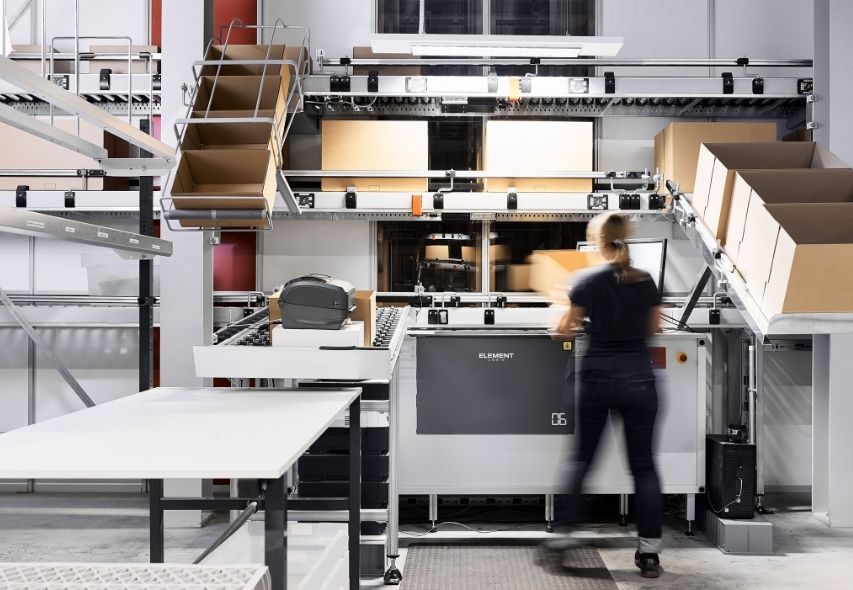Features and innovations
What happens when you consistently push the limits of automation? When the interaction between AutoStore and the Warehouse Management System (WMS) shines with maximum performance? The result is a set-up that is unbeatable in terms of performance and flexibility.
We present five tried-and-tested levers and show what is technically possible - from the incoming goods strategy to the cloud infrastructure.
Every second counts in incoming goods - but so does every item. Manual counting processes quickly reach their limits with bulk items. An effective solution is weighing with counting scales at the workstation directly next to the port. For example, a box of 40 pairs of pants is opened, weighed and then poured into the AutoStore bin.
Why is weighing important? As soon as a carton is opened, the auditor requires a count. However, instead of counting manually, the legal framework also allows the weight to be determined - if it is precisely documented. In this way, the quantity can be clearly determined, the inventory date can be set in the WMS and the goods are immediately available.
Advantage: The storage process is accelerated, employees are relieved and the whole thing remains legally watertight.
Promotional periods such as Black Week or seasonal sales often result in thousands of orders. Many of these consist of just a single item. This is precisely where an optimized special process for single-item orders (EPo) comes into play.
Example: The WMS recognizes that 100 orders contain exactly the same pair of trousers. Instead of picking each order individually, the employee is shown the following message at the port: Pick 100 pieces of this article. The employee counts the 100 items and places them in a trolley. This trolley then travels to the packing department.
The next clever step follows during packing: the WMS shows the employees in the packing department: Here are 100 orders and automatically prints 100 matching shipping labels. These are stuck onto the shipping bags, into each of which a pair of trousers is placed. The bags are then placed on the conveyor system and end up in the correct shipping trolley via a sorting chute, e.g. for DHL or GLS.
Overview of the single item processing procedure:
A special picking option at the AutoStore is the Pick-to-Box variant, which is made possible with the help of intelligent stack planning. The employee picks directly into four shipping cartons at the same time. The process is supported by a pick-to-light system that shows exactly which box the item belongs in. After the picking process, the conveyor system takes over.
Conclusion: This two-stage picking system, Pick-to-Box plus Pick-to-Light, enables high picking performance with a low error rate.
An alternative variant is pick-to-trolley: here, items are not picked directly into shipping cartons, but into picking trolleys with 4 large boxes. This method is suitable for larger orders that cannot be handled using pick-to-box conveyor technology. Each box contains an order that is packed in the manual packing station.
Every centimeter counts when it comes to packaging. That's why the cartons pass through an integrated, fully automated volume reduction and sealing machine on their way to dispatch. These are sensor-controlled and adapt each pack individually to the actual contents.
In concrete terms, this means that the machines cut the cardboard packaging to size, fold the side walls together and seal them with paper tape. The sealed, volume-optimized cartons then travel on to the next station via the conveyor system. There, the parcels receive their shipping label for the respective transport service provider. In the final step, the parcels are sorted via a shipping sorter to the final outgoing goods stations. This is where the final acceptance and palletizing takes place.
Automated shipping process at a glance:
Advantage: The entire process saves packaging material and shipping costs. It reduces manual work and ensures uniform parcels - without any unnecessary air pockets.
A modern and stable warehouse solution is not just a question of technology and processes - but also of a reliable IT infrastructure. This is precisely where our managed cloud infrastructure provides support with security, scalability and low operating costs. We take over the operation and administration of the server and database environments - including patching, monitoring and security management.
For many companies, this is a decisive lever. Setting up and maintaining their own IT infrastructure requires qualified personnel, clear processes for back-up, security and availability. Added to this is the purchase or leasing of the right hardware.
Our managed services relieve and ...
Result: Our managed services enable you to operate your servers in the cloud - scalable, secure and maintenance-free.
The bottom line: AutoStore alone is not enough - the software makes the difference!

